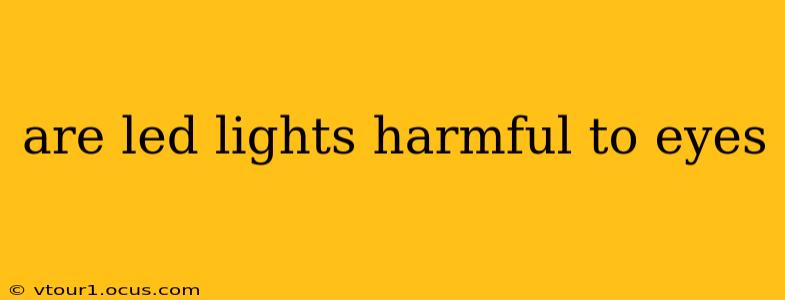The question of whether LED lights are harmful to your eyes is a complex one, with no simple yes or no answer. While generally considered safe, certain aspects of LED lighting warrant consideration. This comprehensive guide will explore the potential risks and benefits, addressing common concerns.
What Makes Some People Worried About LED Lights and Eyes?
Many concerns stem from the way LED lights produce and emit light. Unlike incandescent bulbs that produce a warm, diffused glow, LEDs generate light through semiconductors. This process can lead to specific light characteristics that some find problematic:
-
Blue Light Emission: LEDs emit a higher proportion of blue light compared to other light sources. Blue light is a higher energy wavelength and excessive exposure has been linked to potential eye strain and even long-term issues.
-
Flicker: Some cheaper or poorly designed LED lights can flicker, even if imperceptible to the naked eye. This flickering can cause eye strain and headaches in sensitive individuals.
-
Glare: The intense, directed light of some LEDs can cause glare, especially if improperly shielded or positioned. This glare can lead to discomfort and reduced visual clarity.
-
Intense Brightness: The brightness of LEDs is easily adjustable, but improperly set brightness can be a source of discomfort and eye strain.
Are LED Lights Harmful to Eyes in the Long Term?
The long-term effects of LED light exposure are still being researched. While studies haven't definitively established a causal link between LED lights and serious long-term eye damage in most cases, some potential concerns remain:
-
Macular Degeneration: Some research suggests a possible link between prolonged blue light exposure and increased risk of macular degeneration, a leading cause of vision loss. However, more studies are needed to solidify this connection. It's important to note that many factors contribute to macular degeneration, and blue light is only one potential risk factor.
-
Eye Strain and Headaches: The most common complaint related to LED lights is eye strain and headaches, particularly from prolonged exposure to bright or flickering lights. This is often linked to blue light exposure and glare.
Can LED Lights Cause Eye Damage?
While the risk of direct eye damage from LED lights is relatively low, the potential for indirect harm exists. Direct damage is more likely to occur from staring at extremely intense light sources, regardless of the type of lighting. The more significant concern is the potential for long-term eye strain and potential contribution to eye conditions like macular degeneration through consistent exposure to blue light.
How Can I Minimize the Risks of LED Light Exposure?
Fortunately, several simple measures can significantly reduce the potential risks associated with LED lights:
-
Choose high-quality LEDs: Opt for lights with a low blue light emission and a flicker-free design. Look for certifications like Energy Star.
-
Adjust brightness: Avoid overly bright settings. Adjust the brightness to a comfortable level for the environment and task.
-
Use warm-toned LEDs: Warm-toned LEDs (2700K-3000K) emit less blue light than cool-toned LEDs (5000K-6500K).
-
Take breaks: Regularly look away from screens and bright lights to rest your eyes.
-
Use blue light filtering glasses: Consider using blue light filtering glasses, particularly when using digital devices for extended periods.
-
Proper lighting placement: Avoid direct glare by using lamps and fixtures appropriately.
What About Children and LED Lights?
Children's eyes are still developing, making them potentially more vulnerable to the effects of blue light. Parents should be particularly mindful of the lighting environment for children and implement the precautions mentioned above. Limit screen time and ensure appropriate lighting levels for studying and playing.
Are there alternative lights that are better for your eyes?
While LEDs are energy-efficient and a common choice, alternatives exist with less blue light. Incandescent bulbs, while less energy-efficient, produce a warmer, more diffused light. However, Halogen bulbs and some fluorescent bulbs may also be considered, but their efficiency and environmental impact vary.
In conclusion, while LED lights themselves aren't inherently harmful, certain characteristics warrant careful consideration. By understanding the potential risks and implementing simple preventative measures, you can minimize any negative effects and enjoy the benefits of LED lighting safely. Consult an ophthalmologist if you have specific concerns about your eye health and LED light exposure.
